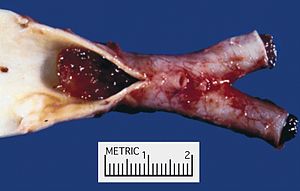Arterial embolus
| Arterial embolism | |
|---|---|
 |
|
| An embolized fragment of an atrial myxoma at the iliac bifurcation (a tumor embolus) | |
| Classification and external resources | |
| Specialty | cardiology |
| ICD-10 | I74 |
| MedlinePlus | 001102 |
Arterial embolism is a sudden interruption of blood flow to an organ or body part due to an embolus adhering to the wall of an artery blocking the flow of blood, the major type of embolus being a blood clot (thromboembolism). Sometimes, pulmonary embolism is classified as arterial embolism as well, in the sense that the clot follows the pulmonary artery carrying deoxygenated blood away from the heart. However, pulmonary embolism is generally classified as a form of venous embolism, because the embolus forms in veins. Arterial embolism is the major cause of infarction (which may also be caused by e.g. arterial compression, rupture or pathological vasoconstriction).
Symptoms may begin quickly or slowly depending on the size of the embolus and how much it blocks the blood flow. Symptoms of embolisation in an organ vary with the organ involved but commonly include:
Later symptoms are closely related to infarction of the affected tissue. This may cause permanently decreased organ function.
For example, symptoms of myocardial infarction mainly include chest pain, dyspnea, diaphoresis (an excessive form of sweating), weakness, light-headedness, nausea, vomiting, and palpitations.
Symptoms of limb infarction include coldness, decreased or no pulse beyond the site of blockage, pain, muscle spasm, numbness and tingling,pallor and muscle weakness, possibly to the grade of paralysis in the affected limb.
...
Wikipedia
